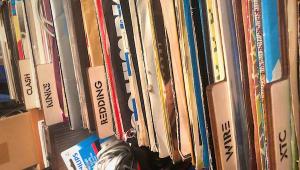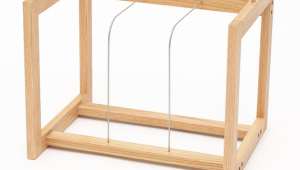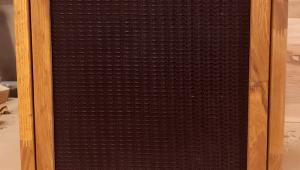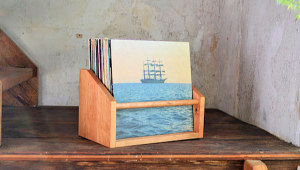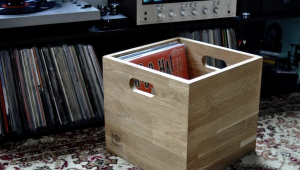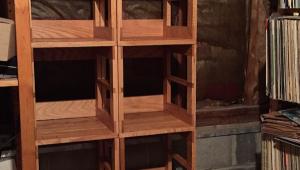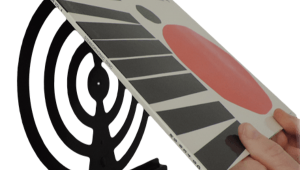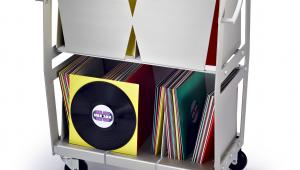i used to do this when i owned a linn turntable but i used 2x2’s and forced them in place worked great, this method is better because u can adjust it when the house changes and the walls and floors shift.
Footfall Fix For Cheap!
I found that out in my first apartment. I had a VPI TNT stand—a solid and massive device that received added mass when I filled the legs with sand and lead shot and the arm still skipped!
The photo shows the solution (assuming your stand is reasonably close to a wall). Simply buy a few proper length threaded rods and open ended bolts and expand until the assemblage presses firmly against the stand and the wall. That will "ground" the stand to the wall and stop it from wobbling. As shown, it's a good idea to put pieces of wood between the bolts and surfaces to spread the pressure and avoid damaging either the wall or the stand.
Do this for a few bucks and the skipping will stop! Then, with the money you save, buy a new stand. Lol.
- Log in or register to post comments

My apartment floor is wooden, and suspended.
Just walking around had the needle skipping.
So I use a pair of turnbuckles against the wall. And have weighted the floor where the stand is with a couple of large rocks from the lake. Looks great and is apparently great for my Feng Shui.

...you are genius ( not that I ever doubted it before).
Your suggestion may solve a problem that I have been stuck with for the past couple of years. My rack is stable vertically and horizontally but apply any torsion (like bumping into a corner) and it is as floppy as can be. Not great for turntable support. Unfortunately the wall behind is not structurally suitable for a wall mounted shelf solution. But this looks like it could do the trick. And at minimal expenditure.
Many thanks.

Just so you know, those open-ended bolts you describe are commonly known as coupling nuts.

...as my old Arcici rack is tall and a bit wobbly with a 35lb TT on the top shelf.
And it's nice to see that I'm not the only one with a rat's nest of cables!

Hard to imagine a room that doesn't have an exterior or load-bearing wall at least adjacent to the listening room front wall. If that's the case, though, I suppose the rod and bolt bracing may be worthwhile.
Still, there's no substitute for wall mounting with 15 or 20 dollars worth of the large shelf brackets HD, Lowes, etc, sell. My table is set on a 2" thick slab of maple, then those HVAC isolation pads between the maple and a piece of Baltic Birch isolated from the brackets by E.A.R. SD-40.
Nothing better, I believe, until one get's to a $50,000 air suspension rack.

Mine is a concrete house step. 3" by 17.5" by 48" wide. Mounted through the wall into upright beams, resting on the foundations. Using two bespoke heavy welded steel brackets with a 45 degree rib of the same steel. Baked black surfaces.
The sources and the heavily tweaked Allen Wright Four-valve pre-amp in a QUAD 22 enclosure, sit on the slab. The super PSU for the Pre is on the floor out of sight.
Includes the Thorens TD150 turntable on a marble slab, on soft STAX feet. An SME 3009/II arm with SME damper and paddles, and a stiff STAX twin-draw-pin head-shell. The cartridge is a VDH'd Denon DL103D into an AT Transformer set to X15. Denneson alignment.
I'd put such wall mounting - sans any contact with the floor - way ahead of the suggested arrangement.

My system is built into a room which was previously a garage. It has a poured slab floor at ground level, with the room's current floor about 18" over that. When we moved here in 1985 I reinforced the wooden floor a bit and had the contractor build a wall system for the stereo, TV, LP's & CD's. The support for the turntable is a cinderblock column which starts on the poured concrete floor and rises through the wooden floor and wall unit, not touching them. Saving wire, here's no mechanical connection between the turntable and the rest of the room. The equipment rack uses a UniStrut sliding-nut and rail system, with shelf standards as well, to flexibly support both rackmount and non-rack gear.

Preach Mikey!
I have been recommending this solution for years, but usually a lower tech version with just something like a block of wood wedged between the back of the rack and the wall.

In some rooms, if you're lucky enough that below the listening room is an unfinished basement, placing a prop jack directly under the rack, pushing up on a board on top that lines up with the front legs of the rack, can work wonders.

There are other problems out in the environment besides footfall that you have to isolate your cartridge from. A properly designed suspension as you would find in a Sota, SME, Basis or Dohmann turntable will do the job in a comprehensive fashion. You can put a Sota Sapphire on a card table jump around right in front of it and it will not miss a beat. You can even hit it with a hammer. If you have a suspensionless turntable you can do the Job as Mr Fremer has with a MinusK platform. A Sota Sapphire costs less than a MinusK stand.

I went to the hardware store within hours of seeing this. My Technics SL 1600 MK2 sits on the standard Ikea record boockase (4x2 cubes) on the second floor of my house. Footfalls were a huge problem. This did not 100% fix the issue but improved it greatly. Now only a hard foot directly in front skips the needle.
I think it also had a slight improvement on overall sound, though that could also be the "I did something so it sounds better" effect. Anyway, I am not a big spender and love these creative solutions.

This problem is as old as Adam and Eve. The wall brace is a partial fix, but the best idea is to either buy a table like a SOTA Sapphire with a proper suspension or use a wall-mounted shelf like Rega used to sell. Walls don't move around like floors do because they are loaded in compression. Floors are loaded in tension like banjo strings. (This is Engineering Mechanics 101 for you Liberal Arts majors).

I had shelf for my Rega way back when, and indeed it was absolutely perfect. But then you upgrade get something heavy that weighs 30-40lbs (or more) and that shelf idea doesn't work so well anymore without some very heavy duty engineering (assuming the studs line up correctly with your overall setup).

I have been lucky to own a vintage Linn LP-12 I bought in 1988 complete with IItok IV arm, Valhalla board and the original Linn Troika MC cartridge (rebuilt three times). The best “tweak” of my vinyl setup -by far- was to mount the table on a low mass wall shelf anchored to studs which are lashed to the exterior brick all resting on the cement foundation. Of course, no more footfall problem (dance anyone?), but the biggest deal was how the bass significantly tightened and deepened and how the soundstage opened up and relaxed. Short of those 200 pound monster turntables now being sold, I can’t see why anyone would not properly wall-mount their deck. Another advantage is the shelf can be situated at chest level meaning you don’t have to bend over to handle your tonearm, a very unstable position for those of us who are of a certain vintage.

This (or a variation of it) is EXACTLY the TT audio life-hack I've needed for years now. I live in a 160 year old house that, though it's built than almost anything you'd find today, with huge cross-beams under the floors and a granite foundation yet... with a listening room on the the second floor it has springy floors like you wouldn't believe! As soon as I read your explanation it all made so much sense as to why it's been near impossible to minimize this issue, let alone solve it. I know just what this weekend's project is going to be, so a huge Thanks!
In fact, my only gripe is: why'd you wait so long, haha!? In all seriousness, this is the type of link that should be permanently pushed to the top of your TIPS section!

This is exact how I coupled the top of my floorstanding speakers to the back wall for an even more accurate sound.

I enjoyed reading this! This covers some important aspects that often get overlooked. Thanks for shedding light on them in such a clear and concise manner.

Der TitanLINK Premium SFP 1000BASE-SX Transceiver ist J4858D HPE-Aruba kompatibel und bietet eine Reichweite von bis zu 1 KM über OM3/OM4 Glasfasern. Mit LC Duplex Anschluss, Digital Diagnostik und konformen Standards wie MSA, RoHS und CE. Ideal für zuverlässige Gigabit-Verbindungen. Jetzt kaufen und profitieren Sie von unserer lebenslangen Garantie!



